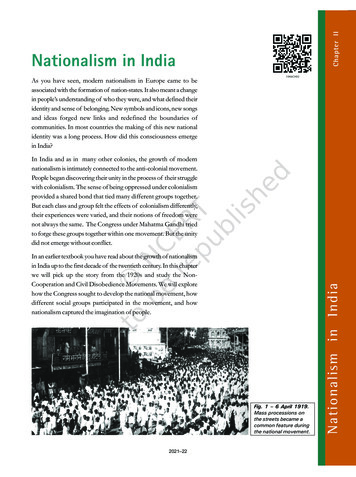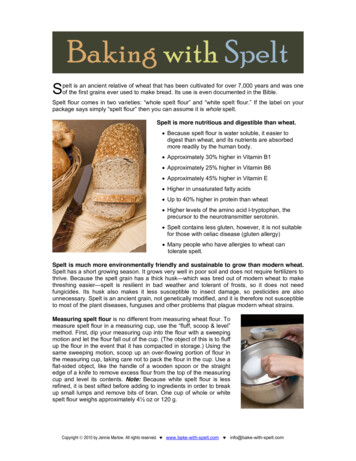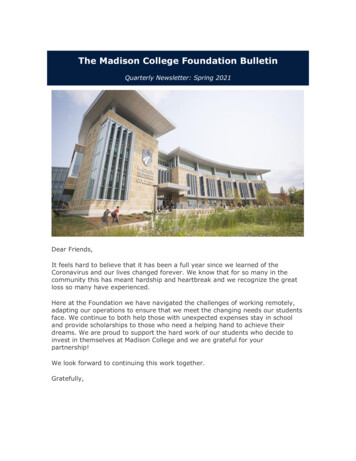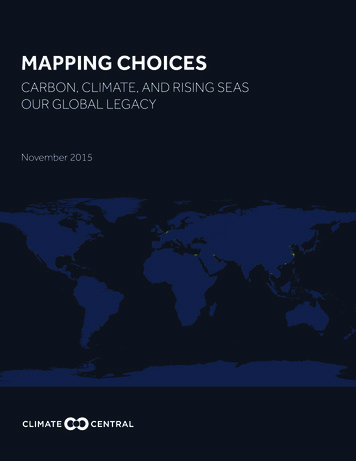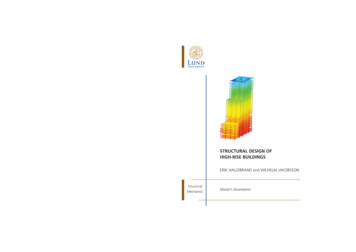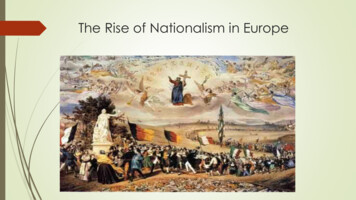
Transcription
The Rise of Nationalism in Europe
WHAT IS NATIONALISM Nationalism is a feeling of belonging and loyalty that causes people think ofthemselves as a Nation. During 19th & 20th centuries Nationalism was a powerful force that couldcreate: One Nation from many separate countries(Ex. Italy & Germany) Break one nation up into many countries(Ex. Austria- Hungary and Turkey )
EUROPEAN SOCIETY THE UPPER CLASS : The landed aristocracywere the dominant group. They had common interest and lifestyle. Owned large country estates andtown houses. Most of them spoke french LOWER CLASS : Majority of the people were peasants. Most were landless and worked as serfs.
French Revolution & The Idea of the Nation French revolution started in 1789. France was a full-fledged territorial state in 1789 under rule of a monarch. Political and constitutional changes that came in wake of the French revolution led to thetransfer of sovereignty from monarchy to a body of French citizens. Various practices adopted to develop a sense of collective identity among people. Declaration of mission to liberate Europe from despotism. Setting up of Jacobin clubs by educated middle classes and students of Europe It also powered revolution in all Europe.
THE IDEA OF THE NATIONALISM Idea of La Patrie (the fatherland) Le Citoyen (the citizen)were emphasized. Adoption of new constitution with citizens enjoying equal rights. Adopted tri color as new French flag replacing royal standards. New hymns were composed oaths were taken & martyrs remembered in the name ofnation. Uniform system of weights & measures were adopted. Centralized administrative system was formulized. French become the national language and regional dialects were discouraged. Imaginary female allegories were used to show united nation. Such as : Marianna&Germania
NEPOLEONIC CODE / COVIL CODE OF 1804 Privileges based on birth abolished and equality before law was established. Right to property was established and feudal system was abolished. Administrative divisions were simplified. Peasants got freedom from serfdom and manorial dues. Uniform laws and standardization of weight and measures were introduced. Common national currency was adopted. Guild restriction in towns was removed and transport and communication system improved.
THE MAKING OF NATIONALISM IN EUROPE Till mid 18th century there was no concept of “Nation State” in Europe. Society and politics was dominated aristocracy. To the west, the land was farmed by tenants and small owners, while in Eastern andCentral Europe by vast estates which were cultivated by serfs. Emergence of working and middle classes due to industrialization in 19 th cent. Educated , liberal middle classes popularized abolition of Aristocratic Privileges.
Liberal NationalismIN POLITICAL SPHERE Government by consent End of Autocracy Adoption of constitution Abolition of property rights. Equality before law Representative Government throughParliamentIN ECONOMIC SPHERE Freedom for market. Removal of state imposed restrictionson movement of goods and capital. In 1834, a customs union Zollverein wasformed . The union abolished tariff barriers andreduced the number of currencies fromover thirty to two.
New Conservatism After 1815 After defeat of Napoleon European governments were driven by a spirit of conservatism. Britain, Russia, Prussia and Austria drew the “Treaty of Vienna” in 1815. Main Motive was to undo the changes initiated by Napoleon and to restore Monarchy.1.Restoration of BourbonDynasty.6. No change in Germanconfederation of 39 states.2.Territories acquired byNapoleon taken back3.Prevented FrenchExpansion in Future4. Austria to controlnorthern Italy7. Russia to get PolaandPROVISIONSOF Treaty ofVienna5. Prussia asgiven neterritories on itswestern borderincluding Saxony.
The Revolutionaries Establishment of Secret Societies to spread the Ideas of nationalism andoppose conservatism. Mazzini viewed “ Nation States” to be necessary and opposed Monarchy. Inspired other secret societies in Germany, France, Switzerland and Poland.Giuseppe Mazzini joined one such society at Carbonan. Later, he established two more Secret societies “Young Italy” in Marseilles,and then, “Young Europe” in Berne. Conservative frightened by his move.
Division of Age of RevolutionAge of Revolution-1830-1848( can be divided under three stages)The RomanticImagination andNational FeelingHunger, Hardshipand PopularRevolt1848: The Revolutionof the Liberals
The Romantic Imagination and National Feeling Use of culture to create idea of a Nation. Romantic artists and poets generally criticized the glorification of reason and science. Focused instead on emotions, intuition and mystical feelings. Used Art Poetry Stories & Music to shape nationalists feelings. Collected Folklores to spread Nationalism even among illiterates. Language also played a vital role for e.g. The use of Polish language in Poland cameto be seen as a symbol of the struggle against Russian dominance.
HUNGER, HARDSHIP AND REVOLT The 1830s were years of great economic hardship in Europe. The first half of the nineteenth century saw an enormous increase in population all over Europe. Large Scale rural migration to cities led to overcrowded cities and reduced Jobs Stiff competition between hand made goods and cheap machine made goods Peasants burdened with feudal dues as in rural areas aristocracy was still enjoying the power. The rise of food prices or a year of bad harvest led to widespread pauperism in town andcountry. Peasants and weavers revolted and Louis Philippe was forced to flee.
The Revolution of the Liberals- 1848 French Monarchy uprooted by revolt of 1848 & a Republic had been proclaimed. Demand of liberal middle classes for constitutionalism with National Unification. In Germany Professionals businessmen, Artisans decided to vote for all German National assembly. Frankfurt Parliament organized in Church of St. Paul. constitution was drafted for a German nation to beheaded by a monarchy subject to a parliament , Offered the crown to Friedrich Wilhelm IV, King of Prussia. He rejected joined other monarchs to oppose theelected assembly
Continued Social base of parliament shifted to middle class dominance. Lost the support of workers and artisans. Political associations were formed by women for Political Rights. Conservative forces suppressed liberals . Fearing future revolutions Monarchs introduced changes . Serfdom and bonded labour abolished.
The Making Of Germany In may 1848 the liberal attempt to set up a constitutional monarchy atFrankfurt was suppressed by the monarchy military and Junkers. After the failure of the German National Assembly , Prussian Chief MinisterOtto von Bismarck took the lead in German Unification Three Wars for 7 years with Austria, Denmark and France completed Germanunification. Prussian King Kaiser William –I become the emperor of United Germany . Currency Banking and Judicial System was legalized
Unification of Italy Italy was divided in 7 states of which only one, Sardinia - Piedmont was ruled by an Italian dynasty. Ideas of Italian unification first given by Giuseppe Mazzini through his Secret Society called YoungItaly. After his failed revolutions in 1831 and 1848 , the lead was taken by the King of Sardinia , VictorEmmanuel -II. Chief Minister of Sardinia, Count Cavour led the unification process by diplomatic alliance withFrance to defeat Austria and unify its northern territories. In the southern part, Giuseppe Garibaldi led the movement by involving local peasant support todrive out the Spanish rulers. Thus the process of unification was completed with the crowning of Victor Emmanuel-II as king ofItaly in 1861.
Otto Von BismarckArchitect of Unification of GermanyGiuseppe MazziniFounder of “Young Italy”
The Strange Case of Britain No British nation existed before 18th century. Ethnic groups like English, Welsh, Scots, inhabited British Isle having their own cultural & PoliticalBases. Growth of English Nations wealth and Power, English parliament seized monarchy in 1688. Act Of Union-1707 between England and Scotland formed United Kingdom of Great Britain. Systematic suppression of Scottish Culture, Language by English began. Many were drive outof their homeland. British helped Protestants against Catholics of Ireland. Later Catholic Revolt as suppressed. In 1801 Ireland was also incorporated forcibly into United Kingdom.
Visualizing Nation Nations began to be portrayed as female figures calledAllegory. Ideas like Liberty ,Justice, and Republic too were personified asfemale figures. Allegories were erected at squares to mark national Unity. Coins and Stamps too carried their images. Marianne represented Republic of France and Germaniaportrayed German Nation
Nationalism and Imperialism: Balkan Issue Balkans become the source of NationalistTension in Europe after 1871 it was too a region of geographical & ethnicvariations Inhabited by slaves & was under control ofOttoman Empire Ideas of nationalism swept over entireBalkan region One by one different Nationalities declaredtheir independence through struggle.
Continued . It became an area of conflict among its Nationalities and later became one of the causesof First World War . Each state develop jealously & hope to expand at the cost of others. European power further complicated the situation . They were struggling to prove their trade & military might over the others. Countries like Russia , Germany, England, Austria- Hungary, extended their control overBalkan Area.
Adopted tri color as new French flag replacing royal standards. New hymns were composed oaths were taken & martyrs remembered in the name of nation. Uniform system of weights & measures were adopted. Centralized administrative system was formulized. French become the national language and regional dialects were discouraged.


